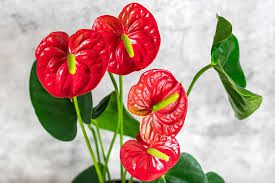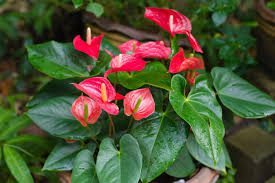The Anthurium plant, also known as the flamingo flower, is a captivating and stunning addition to any indoor space. With its glossy, heart-shaped leaves and vibrant, colorful blooms, this tropical plant has become a favorite among plant enthusiasts and interior decorators alike.
Native to the rainforests of Central and South America, the Anthurium is a member of the Araceae family. Its unique appearance and long-lasting flowers make it a popular choice for bringing a touch of the exotic into homes and offices worldwide.
One of the most striking features of the Anthurium is its flowers. These bright, waxy blooms are available in various colors, including shades of red, pink, white, and even green. The “spathe” or the modified leaf that surrounds the finger-like “spadix” in the center creates the stunning appearance, which resembles a flamingo in flight, thus earning its nickname as the flamingo flower.
Anthurium plants also have the added benefit of improving indoor air quality. They are known to purify the air by removing harmful toxins, making your living space healthier and more pleasant.
In addition, the Anthurium plant is a true beauty with its striking flowers and glossy foliage. Its easy care requirements and air-purifying abilities make it an excellent choice for plant lovers of all levels. Whether you place it on a tabletop, shelf, or as a hanging plant, the Anthurium is sure to add a touch of elegance and tropical charm to your home or office. So, why not bring home an Anthurium and enjoy the delightful presence of this stunning plant.
Read Also: Introduction to Rabbit Rearing
History and Significance of Anthurium Plant

The history of the Anthurium plant dates back centuries, with its origins rooted in the lush rainforests of Central and South America. Indigenous to countries like Colombia, Ecuador, and Venezuela, the Anthurium became known for its unique appearance and vibrant blooms, capturing the attention of botanists and explorers who ventured into these tropical regions.
In the 19th century, European plant enthusiasts and collectors began to discover and cultivate various species of Anthuriums. The first species to be introduced to Europe was Anthurium andreanum, famous for its stunning red spathes and contrasting white spadices. This species quickly gained popularity among plant collectors and horticulturists for its striking beauty and distinctive shape.
In the early 20th century, plant breeders and horticulturists started hybridizing different Anthurium species to create new varieties with a wide range of colors, shapes, and sizes. This led to the development of numerous cultivars that are commonly found in homes and gardens today.
The Anthurium’s popularity skyrocketed in the mid-20th century, thanks to its use in the floral industry. Its long-lasting and eye-catching blooms made it a sought-after flower for bouquets and floral arrangements, especially for special occasions and events. Its ability to thrive in greenhouses and controlled environments also made it a valuable crop for commercial growers.
Besides its ornamental uses, the Anthurium has cultural and symbolic significance in various societies. In some regions of Central and South America, the Anthurium plant is believed to bring good luck and prosperity to the households that cultivate it. It is also considered a symbol of hospitality and warmth, making it a popular gift for welcoming guests.
Additionally, the Anthurium has made its mark in the art world, inspiring numerous artists and designers. Its striking appearance and unique shape have been featured in paintings, sculptures, and other artistic creations.
From a botanical perspective, the Anthurium plant is a member of the Araceae family, which includes other well-known plants like the peace lily and philodendron. The genus Anthurium encompasses over a thousand species, and new hybrids and cultivars continue to be developed, adding to the plant’s diversity and appeal.
Today, the Anthurium plant remains a beloved favorite among plant enthusiasts, both for its visual allure and ease of care. Its ability to thrive indoors, coupled with its air-purifying properties, makes it a popular choice for enhancing indoor spaces with a touch of natural beauty.
However, the history and significance of the Anthurium plant trace a fascinating journey from the tropical rainforests of South America to becoming a cherished and admired houseplant worldwide. Its captivating beauty, cultural symbolism, and contribution to the art and horticultural industries have solidified its place as an enduring and meaningful plant in our lives. Whether as a decorative addition to your living space or a thoughtful gift, the Anthurium continues to enchant and inspire all who encounter its radiant presence.
Uses of the Anthurium Plant

The Anthurium plant has several practical and ornamental uses, making it a versatile and popular choice for various settings. Here are some of its key uses:
1. Indoor Ornamental Plant: One of the primary uses of the Anthurium is as an indoor ornamental plant. Its striking, colorful flowers and glossy foliage add a touch of tropical elegance to homes, offices, hotels, and other indoor spaces. Anthuriums come in a wide range of colors, from vibrant reds and pinks to more subtle whites and greens, making them suitable for various interior design styles.
2. Cut Flowers: Anthurium flowers are widely used in the floral industry as cut flowers. Their long-lasting blooms make them a popular choice for floral arrangements, bouquets, and centerpieces for special occasions, events, and celebrations. As cut flowers, Anthuriums retain their freshness and vibrant appearance for an extended period, making them a favorite among florists and consumers alike.
3. Air Purification: Like many other houseplants, Anthuriums contribute to improving indoor air quality. They help remove harmful toxins such as formaldehyde, ammonia, and xylene from the air, making the environment healthier and more pleasant to live in.
4. Symbolic and Cultural Uses: In some cultures, the Anthurium plant holds symbolic meanings and cultural significance. It is often associated with good luck, prosperity, and hospitality, making it a common gift for housewarming and other celebratory occasions. In weddings and celebrations, Anthuriums are used for decorations and to convey affection and warmth.
5. Gardening and Landscaping: Anthuriums can be cultivated outdoors in suitable climates with warm temperatures and high humidity. In tropical and subtropical regions, they are used for landscaping, adding a touch of color and texture to gardens, parks, and public spaces. Certain varieties are well-suited for planting in shaded areas or as part of a mixed garden display.
6. Research and Botanical Studies: For botanists, horticulturists, and plant enthusiasts, Anthuriums are subjects of interest for research and botanical studies. The genus Anthurium comprises a diverse group of species and hybrids, offering opportunities for scientific exploration, hybridization, and cultivation advancements.
7. Floral Art and Craft: Anthuriums have inspired artists and crafters to incorporate their unique shapes and colors into floral art, flower arrangements, and craft projects. From paintings and illustrations to paper crafts and home decor items, Anthuriums have found their way into various creative expressions.
8. Biophilia and Well-being: As part of the biophilia concept, the presence of Anthuriums and other indoor plants can have a positive impact on human well-being. Their natural beauty and calming effect can reduce stress, improve mood, and create a more nurturing and inviting ambiance.
In addition, the Anthurium plant’s uses span from being a delightful ornamental houseplant to providing cut flowers for floral arrangements and contributing to indoor air purification. Its cultural symbolism, adaptability to various settings, and contributions to art and horticulture make it a beloved and valued plant in different aspects of our lives. Whether for aesthetics, well-being, or cultural significance, the Anthurium remains a cherished and versatile plant that continues to enchant and inspire people worldwide.
Read Also: 10 Health Benefits of Rabbit Meat
Complete Growing and Care Guide of the Anthurium Plant

Anthurium plants, with their vibrant flowers and glossy foliage, are a beautiful addition to any indoor space. Proper care and attention are essential to ensure these tropical beauties thrive and continue to dazzle with their stunning blooms. Follow this complete growing and care guide for Anthurium plants to keep them healthy and thriving:
1. Light Requirements: Anthuriums prefer bright, indirect light. Place them near a window with filtered sunlight, but avoid direct sunlight, as it can scorch their leaves. Inadequate light may result in reduced flowering and slower growth.
2. Temperature: These tropical plants thrive in temperatures between 65°F to 80°F (18°C to 27°C). Protect them from cold drafts and sudden temperature changes, as they are sensitive to chilly conditions.
3. Humidity: Anthuriums prefer high humidity levels. If the air in your home is dry, use a humidifier or place a shallow tray of water near the plant to increase humidity. Misting the leaves regularly can also be beneficial.
4. Watering: Keep the soil evenly moist, but not waterlogged. Water your Anthurium when the top inch of soil feels dry to the touch. Overwatering can lead to root rot, so ensure good drainage and avoid letting the plant sit in standing water.
5. Potting Mix: Use a well-draining potting mix that retains some moisture. A mixture containing peat moss, perlite, and orchid bark works well for Anthuriums. Repot the plant every 1-2 years, preferably in spring, to refresh the soil and give the roots more space to grow.
6. Fertilization: Feed your Anthurium with a balanced liquid fertilizer every two to four weeks during the growing season (spring and summer). Choose a fertilizer specifically formulated for flowering plants. In the dormant winter months, reduce or stop fertilization.
7. Pruning: Remove any yellowing or damaged leaves with clean, sharp scissors. Pruning helps the plant allocate its energy more efficiently and promotes new growth. Cut spent flowers near the base to encourage continuous blooming.
8. Pest and Disease Control: Anthuriums are generally resistant to pests, but occasionally, they may be affected by common houseplant pests like aphids, mealybugs, or spider mites. Regularly inspect the leaves and stems, and if you notice any pests, treat the plant with insecticidal soap or neem oil. Ensure good air circulation to prevent fungal diseases.
9. Support and Training: Anthuriums have aerial roots that may attach to support structures. You can gently train these roots or provide a stake or trellis to help the plant grow upright and maintain its shape.
10. Propagation: Anthuriums can be propagated through division or stem cuttings. To propagate by division, carefully separate offsets or new shoots from the main plant, making sure each division has its roots. For stem cuttings, take a 6-inch section from a healthy stem with at least two leaves, dip the cut end in rooting hormone, and plant it in a well-draining medium. Provide warmth and humidity to encourage root development.
11. Toxicity: Keep in mind that Anthuriums are toxic to pets and humans if ingested. Keep them out of reach of curious pets and children, and wash your hands after handling the plant.
By following these care guidelines, you can enjoy the beauty of Anthurium plants as they bloom and thrive in your indoor space. With a little attention and affection, these captivating tropical plants will continue to brighten up your home with their mesmerizing flowers and glossy foliage.
Read Also: Efficient Solutions for Food Waste Disposal
